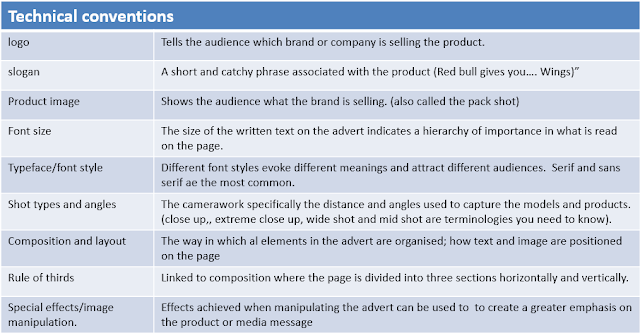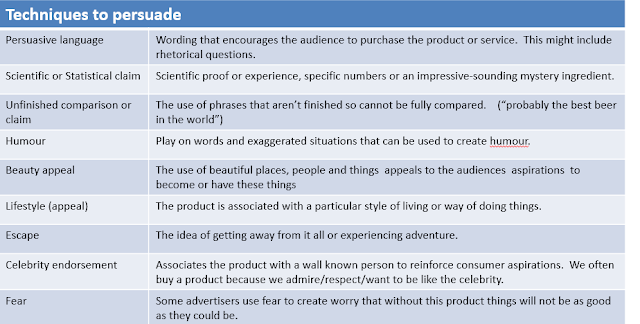Advertising & Marketing
Media language : How the media through
their forms, codes, conventions and techniques communicate meaning(s).
Representations
How the media portray events issues,
individuals and social groups
Advertising: Is
the process of making a product or service known to the
market and the target
audience.
Adverts as a media form.
Print advertising uses physically printed
media and usually appears in magazines, newspapers, billboards or posters.
•Genre
conventions of camera, editing, sound and mise en scene.
oHow
are these elements used together to construct the media form so that it looks
the way it does,
oHow
are these elements organised and combined in a certain way to communicate
meaning in the set product.
oHow
does the genre develop through the use of technical elements
•How
does the contents incorporate the viewpoints and ideology of the producer?
•How
can multiple meanings be communicated and interpreted by producer and
audience.
In social psychology, a stereotype is an over-generalized belief about a particular category of people. It is an expectation that people might have about every person of a particular group. The type of expectation can vary; it can be, for example, an expectation about the group's personality, preferences, or ability.
Social context, also called social environment, refers to the settings surrounding individuals, including the culture they live in and groups that they interact with. Social context influences customs, traditions and other socially acceptable standards.
Cultural context looks at the society the characters live in and at how their culture can affect their behaviour and their opportunities. Think about where and when each text is set. Think about the values and attitudes that matter to these characters and about how they formed.
The anchors for this ad is when men see someone attractive or that they like they start to get sweaty and nervous, so this deodrant will help to stop this from happening when they see them.
Complementry Colours are opposite each other whereas analogus colours are next to each other, so they used blue and yellow to stand out and the blue could also link to hydration.
Lucozade Context-
Created 1927 as Glucozade- meant to give energy to the sick
Renamed Lucozade in 1929
1983 rebranded as a sports drink rather than a health drink
In social psychology, a stereotype is an over-generalized belief about a particular category of people. It is an expectation that people might have about every person of a particular group. The type of expectation can vary; it can be, for example, an expectation about the group's personality, preferences, or ability.
Social context, also called social environment, refers to the settings surrounding individuals, including the culture they live in and groups that they interact with. Social context influences customs, traditions and other socially acceptable standards.
Cultural context looks at the society the characters live in and at how their culture can affect their behaviour and their opportunities. Think about where and when each text is set. Think about the values and attitudes that matter to these characters and about how they formed.
Complementry Colours are opposite each other whereas analogus colours are next to each other, so they used blue and yellow to stand out and the blue could also link to hydration.
Lucozade Context-
Created 1927 as Glucozade- meant to give energy to the sick
Renamed Lucozade in 1929
1983 rebranded as a sports drink rather than a health drink
TV campaign 'Last Man Standing' launched in Jan 2013 ITV during the FA
Lucozade hydrates and fuels you better than water.
Soft Drinks Adverts-
Preferred or dominant- They agree with the adverts's meaning and buy the product
Negotiated- They accept the message from the advert but may not want to buy the product
Oppositional- They reject the message from the advert and will not buy the product.
An able bodied man would have a dominant reaction of the advert due to the fact that it is relating towards him as most men like football or play it, so if he saw the advert from an professional football player its likely that they will buy it to either improve their perfromance if its within a football player or get it due to the name. The colouring is advertised more to males with the fact that blue is predominantly a masculine colour so it catches their attention to buy the product therefore putting himself in the preferred or dominant section.
A woman would have an negotiated approach to this because even though its not aimed at them some women who play football might use it for the same reason men use it, so even though its aimed at men a woman can still go and buy it and get the same effects, however because there is more men that play football they are using them to advertise it becuase it will have a bigger impact on the sales than it would for if a woman was to advertise it, leading to an idea of partriarchy and bias within sports, putting them in the negotiated section. It also links to the stereotype that men require more physical activity.
A man with a physical disability would have an oppositional approach to this or feel left out and a bit angry in a way because they know that it is not aimed at them but it still hurts them to see it as they might of recently gained an injury that linked to the physical disability from playing that sport previously. This advert is mostly focused on sporting advertising which can't relate to everyone so they generalised it to who it appeals to mostly. They could feel offended by the situation but if they looked up to that person they may not buy it for the sports part of it which includes improving performance.

















No comments:
Post a Comment